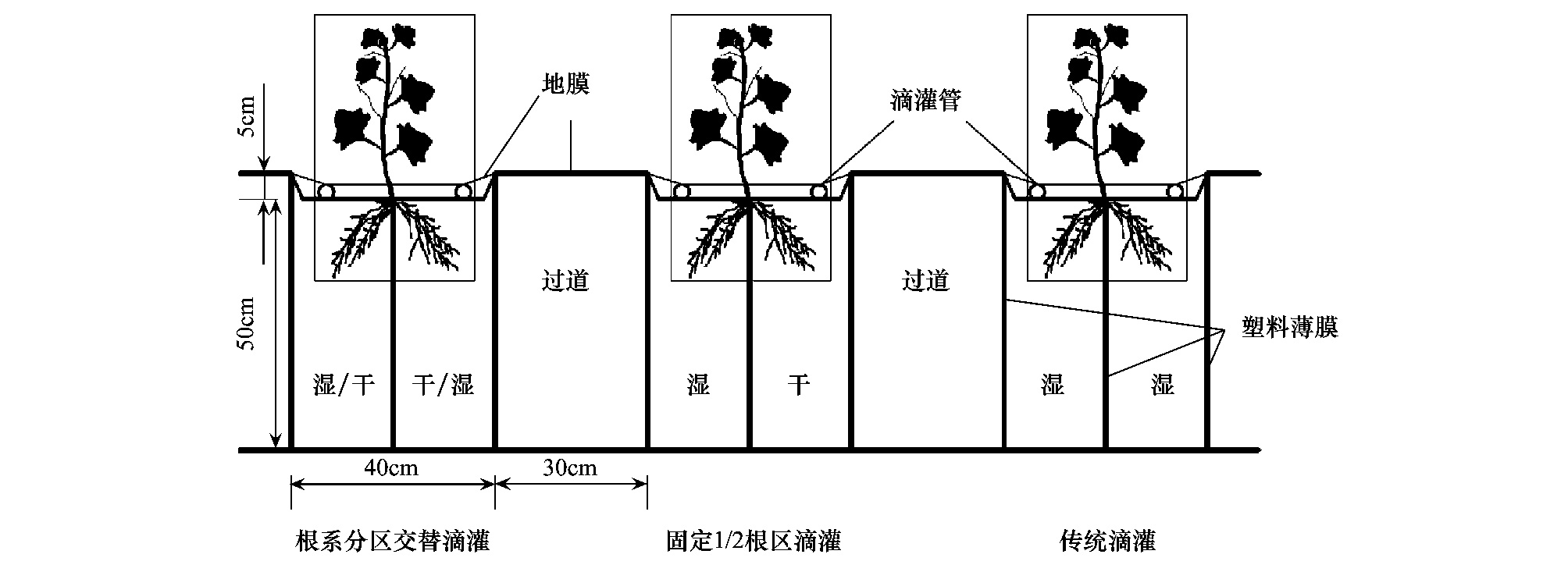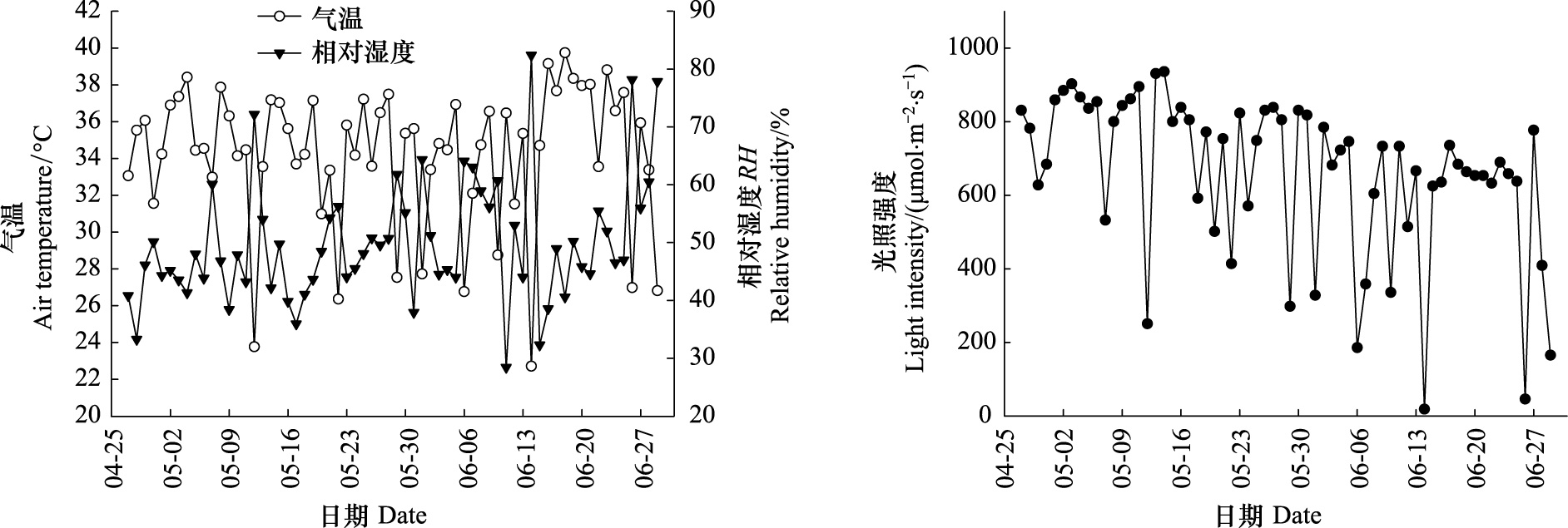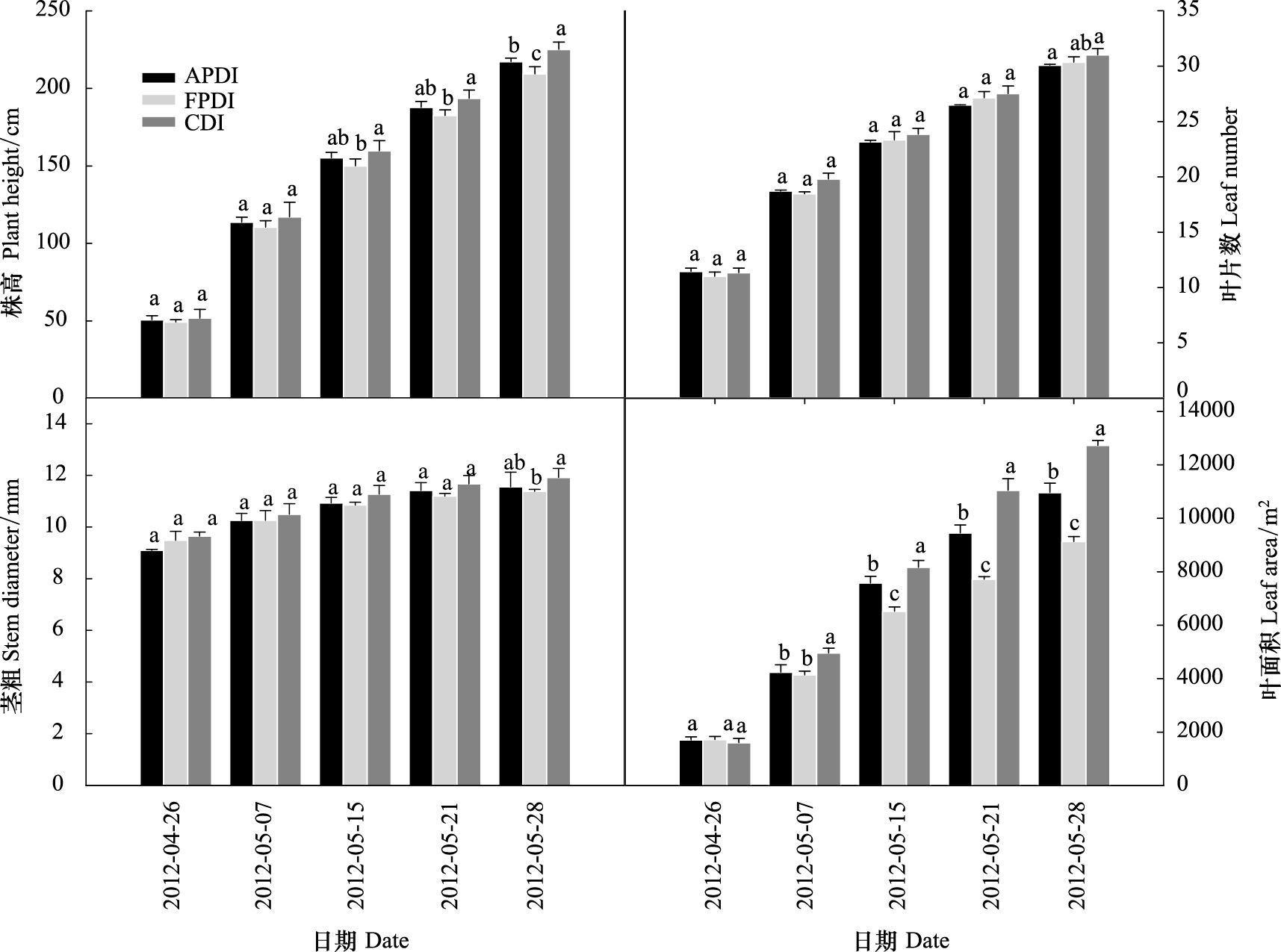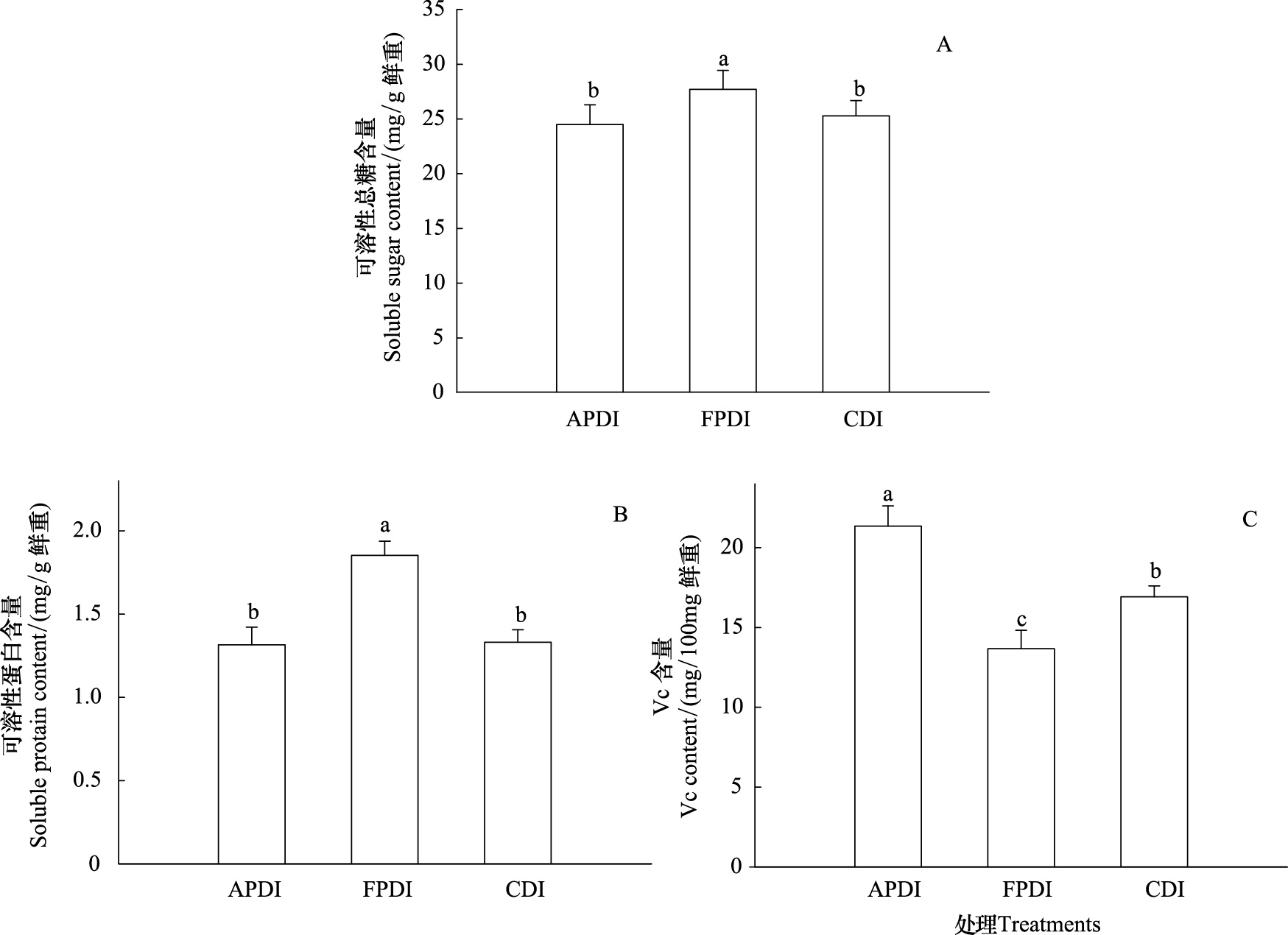文章信息
- 赵志成, 杨显贺, 李清明, 刘彬彬, 杨振超
- ZHAO Zhicheng, YANG Xianhe, LI Qingming, LIU Binbin, YANG Zhenchao
- 不同膜下滴灌方式对设施黄瓜生理特性及水分利用效率的影响
- Effects of different drip irrigation methods under plastic film on physiological characteristics and water use efficiency of protected cucumber
- 生态学报, 2014, 34(22): 6597-6605
- Acta Ecologica Sinica, 2014, 34(22): 6597-6605
- http://dx.doi.org/10.5846/stxb201302160270
-
文章历史
- 收稿日期:2013-2-16
- 网络出版日期:2014-3-17
2. 作物生物学国家重点实验室, 泰安 271018;
3. 西北农林科技大学园艺学院, 杨凌 712100
2. State Key Laboratory of Crop Biology, Tai'an 271018, China;
3. College of Horticulture, Northwest Agriculture and Forestry University, Yangling 712100, China
中国是一个严重缺水的国家,目前缺水约300—400亿m3,其中农业用水量占年总用水量的70%以上,农业节水首当其冲,节水农业势在必行[1]。随着全球气候变暖、水资源紧缺以及耕地面积的下降,有关生物节水的研究已成为科学界研究的热点。如何通过改变作物根系区域的土壤湿润方式,调节根土系统的生产功能,实现节水优质高效生产,对我国农业节水和水资源高效利用具有重要意义[2]。根系分区交替灌溉就是交替对作物部分根区进行灌溉而部分根区干旱,从而改变根区剖面土壤湿润方式的一种节水灌溉模式[3],其可利用干湿交替所产生的根系补偿效应,刺激根系的生长,提高根系的吸收能力,促进根系对水分及矿质营养元素的吸收[4, 5];优化光合产物的分配,减少生长冗余[6];并通过根系产生的根源信号物质(ABA)调节气孔开度,减少奢侈蒸腾耗水,在不降低或少量降低作物光合产物积累的基础上显著提高水分利用效率[7, 8, 9, 10, 11, 12],改善产品品质[6, 13, 14, 15, 16]。近年来我国设施栽培发展迅猛,为盲目追求高产,“大水大肥”的现象较为普遍,不仅造成水肥资源的浪费,还导致设施环境湿度增大,病虫害的发生严重。因此在设施栽培条件下如何节水提质增效是一个亟待解决的问题。黄瓜是一种对水分非常敏感的蔬菜作物[17],由于其根系较浅、好气性强且以水平分布为主,对土壤深层水分吸收能力差,加上地上部叶片蒸腾量大,因而喜湿不耐涝,对水分管理要求较高[18]。而分根交替灌溉的研究主要集中在小麦、玉米、棉花等大田作物和果树上,对设施黄瓜膜下交替灌溉节水效果的研究还未见报道。本试验以黄瓜为研究对象,通过研究膜下根系分区交替滴灌对其生长、生理特性、产量与品质及水分利用效率的影响,旨在探明膜下交替灌溉对设施黄瓜的节水提质增效机理,为设施黄瓜节水灌溉提供理论依据和技术参数。
1 材料与方法 1.1 试验材料试验于2012年在山东农业大学园艺实验站塑料大棚中进行。供试黄瓜(Cucumis sativus L.)品种为‘津优3号’(天津科润黄瓜研究所),采用10 cm×12 cm营养钵育苗,3月6日浸种催芽,4月7日定植。土壤条件为有机质3.8%,碱解氮226 mg/kg,速效磷74 mg/kg,速效钾596 mg/kg,土壤容重1.08 g/cm3,田间持水量38%。
1.2 试验设计与方法试验设根系分区交替滴灌(APDI)、固定1/2根区滴灌(FPDI)和传统滴灌(CDI)3个处理,随机区组排列,3次重复。试验采用槽式栽培,土槽长9 m,宽0.4 m,深0.5 m,槽间距0.6 m,小区面积9.0 m2。土槽四周以塑料薄膜相隔,中部纵向也用0.5 m深的塑料薄膜隔开,以防水分侧渗。中部塑料薄膜每30 cm剪一个“V”型口,黄瓜苗长至三叶一心时,洗根,将根均匀分开定植在“V”型口处,每小区定植30株。植株两侧各铺设一条滴灌带,覆盖地膜,采用膜下滴灌。设土壤灌溉水分下限为田间持水量的65%,上限为田间持水量的90%,当含水量降至或接近该处理水分下限即进行灌水,灌水至水分控制上限。灌水量依公式计算[19]:
M滴灌 = r × p × h × θf× (q1-q2) / η
式中,r为土壤容重,为1.08 g/cm3;p为土壤湿润比,取100%;h为灌水计划湿润层,取0.5 m;θf为田间持水量,为38%;q1、q2分别为土壤水分上限、土壤水分下限;η为水分利用系数,滴灌取0.9。试验设计示意图见图 1。

|
| 图 1 黄瓜不同膜下滴灌方式示意图 Fig. 1 Layout of different drip irrigation methods of cucumber under plastic film |
土壤含水量采用WET土壤水分测量仪(Delta-T,UK)测定,用精密度为0.1 L的水表记录灌水量,分别用HOBO Pendant温度/光强记录仪和HOBO U12数据采集器(Onset Computer Corporation,USA)连续监测塑料大棚内气温、相对湿度和光照强度,试验期间塑料大棚内环境因子动态变化如图 2所示(选择每天10:00数据作图)。4月26日水分开始处理时测定一次形态指标,然后从5月7日起,每隔7 d测定1次。测定时每小区选取5株,株高用卷尺从主茎靠近地表处起测。茎粗(第5—6节间)用游标卡尺测定。单株叶面积为从下往上数第6叶起至初生平展叶叶面积之和,单叶叶面积用直尺测其叶长(LL)与叶宽(WL),根据经验公式计算[20]:
SL= 0.5 WL× LL+ 0.25 × WL2

|
| 图 2 处理期间塑料大棚环境因子动态变化 Fig. 2 Variation of environmental factors in plastic-covered tunnel during treatments |
叶片数目测测定,以叶片平展算起。光合气体交换参数采用CIRAS-1型光合仪(PP System,USA)选择晴朗天气的9:30时至11:00时进行,每个处理选取长势一致的黄瓜植株,并从上往下数第4—6片功能叶进行测定。在测定光合参数的同时采用FMS-2型脉冲调制式荧光仪(Hansatech,UK)测定叶绿素荧光参数。叶绿素含量采用80%丙酮浸提法测定。黄瓜可溶性总糖、可溶性蛋白、维生素C分别采用蒽酮比色法、考马斯亮蓝G-250法及2,6-二氯靛酚比色法测定[21]。
1.4 数据分析及处理采用DPS 6.55数据处理系统进行数据统计分析,Duncan检验法对显著性差异(P<0.05)进行多重比较;SigmaPlot 10.0(SPSS Science,Chicago,IL,USA)作图。
2 结果与分析 2.1 不同灌溉模式对黄瓜生长指标的影响不同灌溉处理对黄瓜生长影响较大。由图 3可 以看出,不同灌溉模式下植株生长指标的差异显著性随生育期的延长出现逐渐增大的趋势,CDI处理在株高、茎粗、叶面积及叶片数上均高于其他处理,APDI处理介于CDI处理和FPDI处理之间。其中CDI处理的植株叶面积在5月7日水分处理10 d后与其他处理的差异就达到了显著水平,而不同灌溉处理之间黄瓜植株茎粗和叶片数差异并不显著(图 3),说明茎粗和叶片的分化并未受灌溉模式的影响,APDI和FPDI处理主要是由于植株受到不同程度的水分胁迫,部分限制了黄瓜植株节间的伸长和叶面积的扩展。

|
| 图 3 不同灌溉模式对黄瓜形态指标的影响 Fig. 3 Effects of different irrigation pattern on morphological indexes of cucumber APDI: 根系分区交替滴灌;FPDI: 固定1/2根区滴灌;CDI: 传统滴灌 |
不同灌溉处理对黄瓜植株地上部影响较大,由表 1可以看出,在传统滴灌模式下,植株长势强壮,地上部鲜重和干重均大于其他处理,而且与各处理之间差异达显著水平。根鲜重和根干重的变化趋势与地上部变化趋势一致,CDI处理最大,APDI处理次之,FPDI处理最小。根冠比APDI处理较FPDI处理显著提高,与CDI处理之间差异不显著,说明FPDI处理由于受到相对较重的水分胁迫,从而抑制了黄瓜根系的生长发育。
| 处理 Treatments | 地上部鲜重/g Shoot fresh mass | 地上部干重/g Shoot dry mass | 根鲜重/g Root fresh mass | 根干重/g Root dry mass | 根冠比 Root-shoot ratio |
| 表中APDI 为Alternate partial root-zone drip irrigation,FPDI为Fixed partial root-zone drip irrigation,CDI为Conventional drip irrigation;数据后小写字母为不同处理间Duncan多重比较的差异显著性(α=0.05) | |||||
| 根系分区交替滴灌APDI | 828 b | 93.6 b | 42.8 a | 3.04 a | 0.0325 a |
| 固定1/2根区滴灌FPDI | 750 c | 89.3 b | 34.0 b | 2.56 b | 0.0287 b |
| 传统滴灌CDI | 1033 a | 110.5 a | 46.7 a | 3.41 a | 0.0309 ab |
从表 2中可以看出,APDI处理的叶绿素a、叶绿素b、叶绿素a+b、叶绿素a/b及类胡萝卜素含量与CDI处理相比差异均不显著,而FPDI处理的叶绿素a、叶绿素b、叶绿素总量较CDI处理显著下降,叶绿素a/b显著上升,说明FPDI处理影响了叶片叶绿素的合成。
| 处理 Treatments | 叶绿素a Chl a/(mg/g) | 叶绿素b Chl b/(mg/g) | 叶绿素a+b Chl a+b/(mg/g) | 叶绿素a/b Chl a/b | 类胡萝卜素 Carotenoid/(mg/g) |
| 根系分区交替滴灌APDI | 1.167a | 0.289 a | 1.455 a | 4.04 b | 0.314 a |
| 固定1/2根区滴灌FPDI | 1.061 b | 0.246 b | 1.307 b | 4.32 a | 0.298 a |
| 传统滴灌CDI | 1.196 a | 0.295 a | 1.491 a | 4.06 b | 0.329 a |
黄瓜叶片光合气体交换参数对不同灌溉模式的响应不同。由表 3看出,与CDI处理比较,APDI处理和FPDI处理的叶片净光合速率(Pn)有不同程度的下降,分别下降了7.4%、15.9%。叶片蒸腾速率(Tr)与Pn的变化趋势一致,较CDI处理分别下降了13.5%、21.6%。就叶片水分利用效率(WUEl)而言,APDI与FPDI处理均显著提高了WUEl,较CDI处理分别提高了7.0%和7.2%。
| 处理 Treatments | 净光合速率 Pn /(μmol m-2 s-1) | 气孔导度 Gs /(mmol m-2 s-1) | 胞间CO2浓度 Ci /(μmol/mol) | 蒸腾速率 Tr /(mmol m-2 s-1) | 水分利用效率 WUEl /(μmol/mol) |
| 根系分区交替滴灌APDI | 17.5 ab | 201 b | 203 a | 3.45 ab | 5.07 a |
| 固定1/2根区滴灌FPDI | 15.9 b | 181 b | 179 b | 3.13 b | 5.08 a |
| 传统滴灌CDI | 18.9 a | 236 a | 210 a | 3.99 a | 4.74 b |
由表 4可以看出,不同灌溉模式对黄瓜叶片叶绿素荧光参数Fo、Fm、Fs和Fv/Fm均无显著影响。虽然APDI和CDI处理的个荧光参数均无显著差异,但是FPDI处理的Fm′和ΦPSⅡ显著下降而NPQ显著上升,说明FPDI处理由于一侧固定干旱而导致叶片光化学效率的显著降低,光合作用电子传递受阻,非光化学热耗散显著增加。
| 处理 Treatments | 初始荧光 Fo | 饱和脉冲光下 最大荧光 Fm | 稳态荧光 Fs | 光化光下 最大荧光 Fm′ | PSⅡ最大光 化学效率 Fv/Fm | PSⅡ实际光 化学效率 ΦPSⅡ | 非光化学淬灭 NPQ |
| 根系分区交替滴灌APDI | 125 a | 661 a | 123 a | 256 a | 0.811 a | 0.519 a | 1.58 b |
| 固定1/2根区滴灌FPDI | 122 a | 654 a | 119 a | 230 b | 0.813 a | 0.48 b | 1.84 a |
| 传统滴灌CDI | 124 a | 648 a | 124 a | 263 a | 0.809 a | 0.528 a | 1.46 b |
黄瓜果实生长发育较快,在短时间内需要黄瓜植株向果实输送大量的水分和养分。由图 4以看出,APDI处理的可溶性糖和可溶性蛋白含量与CDI处理差异不显著,Vc含量则显著高于其他处理,而FPDI处理的黄瓜果实可溶性糖和可溶性蛋白含量均高于其他处理,但Vc含量较其他处理显著下降,说明分根交替滴灌可以交替给黄瓜根系创造一个适度的干旱胁迫的环境,在可溶性糖和可溶性蛋白含量不显著降低的情况下显著提高Vc的含量,从而提高黄瓜的品质。

|
| 图 4 不同灌溉模式对黄瓜品质的影响 Fig. 4 Effect of different irrigation pattern on the quality of cucumber |
由表 5以看出,产量和灌水量CDI处理均高于APDI和FPDI两个处理,而水分利用效率则是CDI最低。APDI处理产量比CDI处理略有下降,但差异不显著,而灌水量和水分利用效率差异达显著水平,灌水量较CDI处理降低了17%,进而水分利用效率提高了18.6%,节水效果非常明显。同样FPDI处理的节水效果也非常明显,灌水量比CDI处理降低了28.3%,进而水分利用效率提高了32%,但产量却降低了8%,差异达显著水平。说明分根交替滴灌能够在保持产量相当的基础上,能够显著减少灌水量,提高水分利用效率,达到节水的目的,而固定1/2根区滴灌虽然节水效果显著,但是却以降低产量为代价。
| 处理 Treatments | 结瓜数 Fruiting number | 单瓜重 Fruit weight /g | 产量 Yield /(g/m2) | 灌水量 Irrigation volume /(kg/m2) | 水分利用效率 Water use efficiency /(g/kg) |
| 根系分区交替滴灌APDI | 269 a | 235.0 a | 7023 a | 183.9 b | 38.2 b |
| 固定1/2根区滴灌FPDI | 251 b | 235.3 a | 6562 b | 159.0 c | 42.5 a |
| 传统滴灌CDI | 265 a | 242.2 a | 7130 a | 221.7 a | 32.2 c |
控制性交替灌溉追求的是非充分但适当的灌溉水量与不均匀的土壤水分分布,创造一个适度的干旱土壤环境,激发植物的节水潜能[22]。已有研究表明植物体在遭受轻微的水分胁迫就会明显的抑制植物的生长,直接反映在生长量上[23]。由于细胞的伸长比细胞的分裂对水分胁迫更加敏感,干旱胁迫会显著影响温室黄瓜的叶面积相对扩展速率[24],APDI处理根系交替受到水分胁迫,黄瓜植株的生长尤其是叶面积的扩展受到一定的影响,显著低于CDI处理。植物地上部与地下部对光合产物的分配存在着此消彼长的关系,植物体在遭受水分胁迫时,会改变光合产物在根与冠之间的分配比例,并随土壤含水量的增加,黄瓜根冠比呈递减趋势,遵循“旱长根、湿长叶”的基本规律[19, 25]。APDI处理根系交替经受水分胁迫锻炼,刺激根系的生长,增加了干物质向根系的分配,提高了根冠比,从而更有利于对水分和养分的吸收。FPDI处理由于一侧根系持续干旱,水分及养分供应不足,株高和叶面积均低于CDI和APDI处理,但是其灌水一侧为维持地上部对水分的需求,根系向纵深发展,体现出植物对环境条件的调节适应能力。
叶绿素作为植物最重要的光合色素起着吸收、传递和转换光能的重要作用,是光合作用的基础,同时也间接反映黄瓜植株的生长状况。有关水分胁迫对作物叶片叶绿素含量的研究表明,随着土壤水分胁迫增加,叶绿素含量下降[26]。本试验在土壤肥力供应充足的情况下,与CDI相比,APDI处理的叶绿素含量差异不显著,而FPDI处理叶绿素含量显著下降,可能是由于其根系一侧持续干旱,导致根系生长受到抑制,影响了水分与养分的吸收与供应,阻碍了叶绿素的合成,进而导致Pn显著下降。与此同时,FPDI处理由于持续干旱产生的胁迫信号物质传输至地上部叶片,引起Gs显著下降,也导致Pn显著降低。APDI和FPDI处理Gs和Ci的都表现出显著降低的变化趋势,说明这两种灌溉模式下Pn的下降是主要是由于气孔因素造成的[27, 28],而APDI和FPDI处理的Tr的下降较Pn更为明显,从而引起WUEl的显著提高。叶绿素荧光动力学技术在测定叶片光合作用过程中光系统对光能的吸收、传递、耗散、分配等方面具有独特的作用,与“表观性”的气体交换参数相比,叶绿素荧光参数更具有反映“内在性”特点[29]。水分胁迫通过限制光能的吸收、传递以及转换效率,抑制了光合电子传递过程[30]。本试验结果表明APDI和FPDI处理其Fv/Fm与CDI无显著差异,说明分根滴灌并未对光合机构造成伤害。尽管APDI处理的ΦPSⅡ和NPQ与CDI处理之间差异不显著,但FPDI处理的ΦPSⅡ显著下降而NPQ显著上升。由表 3中的光合数据得知,FPDI处理Pn较CDI处理显著下降,这说明由于FPDI处理光合系统中碳同化速率下降,造成过多的激发能没有得到及时利用,电子传递受阻,从而导致了实际光化学效率显著下降,非光化学猝灭显著升高。
就不同灌溉模式对产量的影响而言,FPDI处理结瓜数显著降低,说明FPDI处理由于根系一侧的持续干旱不利于坐瓜,而APDI处理的结瓜数、单瓜重和产量与CDI处理均无显著差异(表 5),因为APDI处理的叶绿素含量与CDI处理无显著差异,净光合速率也无显著差异(表 2和表 3),虽然植株生长量低于对照,但交替滴灌可以优化光合产物的分配,减少生长冗余,调整营养生长与生殖生长的分配比例,这可能是APDI处理产量与CDI处理差异不显著的主要原因之一。曹琦等人在黄瓜上的研究结果表明,交替隔沟灌溉减少了土壤水分的深层渗漏和土壤表面水分蒸发,可节水37%—48%,控漏减蒸效果明显[31]。本试验研究结果表明,不同灌溉处理对水分利用效率的影响中,CDI处理在两侧充足均匀的灌水条件下,有着较高的气孔导度、光合速率和蒸腾速率,但叶片水分利用效率显著低于APDI处理和FPDI处理,存在着无效的奢侈蒸腾散失,而交替滴灌不仅可以减少棵间蒸发损失和深层渗漏,而且叶片蒸腾速率显著下降,产量较CDI处理无显著差异,灌水量减少17%而水分利用效率提高18.6%。
综上所述,与传统滴灌相比,分根交替膜下滴灌模式可增加黄瓜的根冠比,显著降低叶片蒸腾速率,提高叶片水分利用效率,产量仅下降1.5%,而灌水量减少17%,水分利用效率提高18.6%,节水效果十分显著。因此,分根交替滴灌可以在保证设施黄瓜产量没有显著下降的前提下,改善品质和显著提高水分利用效率,可作为设施节水提质增效的一种灌溉模式,推广应用前景广阔。
| [1] | Shi Y C. To raise the water use efficiency by modern biotechnology. Science and Technology Review, 1999, (10): 3-5. |
| [2] | Du T S, Kang S Z, Zhang J H. Water-saving and crop quality improvement of alternate partial root-zone irrigation and application of isotope technology in the research of crop water use. Plant Physiology Journal, 2011, 47(9): 823-830. |
| [3] | Kang S Z, Zhang J H, Liang Z S, Hu X T, Cai H J. The controlled alternative irrigation a new approach for water saving regulation in farmland. Agricultural Research in the Arid Areas, 1997, 15(1): 1-6. |
| [4] | Han Y L, Kang S Z. Effects of controlled root-divided alternative irrigation on nutrient uptake in maize. Irrigation and Drainage, 2001, 20(2): 5-7. |
| [5] | Li Z J, Zhang F C, Kang S Z. Impacts of the controlled roots-divided alternative irrigation on water and nutrient use of winter wheat. Transactions of the Chinese Society of Agricultural Engineering, 2005, 21(8): 17-21. |
| [6] | Du T S, Kang S Z, Xia G M, Yang X Y. Response of grapevine growth and water use to different partial root-zone drying patterns under drip irrigation. Transactions of the Chinese Society of Agricultural Engineering, 2005, 21(11): 43-48. |
| [7] | dos Santos T P, Lopes C M, Rodrigues M L, de Souza C R, Maroco J P, Pereira J S, Silva J R, Chaves M M. Partial rootzone drying: effects on growth and fruit quality of field-grown grapevines (Vitis vinifera). Functional Plant Biology, 2003, 30(6): 663-671. |
| [8] | Du T S, Kang S Z, Yan B Y, Wang F, Li Z J. Experimental research of high-quality efficient irrigation on grape in the oasis region. Transactions of the Chinese Society of Agricultural Engineering, 2007, 23(11): 52-58. |
| [9] | Li P, Qi X B, Fan X Y, Wu H Q, Qiao D M, Fan T, Zhao Z J, Huang Z D, Zhu D H. Effect of alternate partial root-zone irrigation on nitrogen and water use efficiency of potato. Transactions of the Chinese Society of Agricultural Engineering, 2009, 25(6): 92-95. |
| [10] | Lin Y C, Zeng Z H, Ren C Z, Hu Y G. Water use efficiency and physiological responses of oat under alternate partial root-zone irrigation in the semiarid areas of Northeast China. Procedia Engineering, 2012, 28: 33-42. |
| [11] | Zhang L D, Gao L H, Zhang L X, Wang S Z, Sui X L, Zhang Z X. Alternate furrow irrigation and nitrogen level effects on migration of water and nitrate-nitrogen in soil and root growth of cucumber in solar-greenhouse. Scientia Horticulturae, 2012, 138: 43-49. |
| [12] | Yang Q L, Zhang F C, Li F S, Liu X G. Hydraulic conductivity and water-use efficiency of young pear tree under alternate drip irrigation. Agricultural Water Management, 2013, 119: 80-88. |
| [13] | Liu Y X, Li F S, Nong M L. Effects of alternate partial root-zone irrigation on water saving and quality regulating of flue-cured tobacco at different growth stages. Transactions of the Chinese Society of Agricultural Engineering, 2009, 25(1): 16-20. |
| [14] | Yang S M, Li B G, Qi G H, Guo S P, Hu Z W. Effects of alternate partial rootzone irrigation on roots activity, stem sap flow and fruit of apple. Transactions of the Chinese Society of Agricultural Engineering, 2010, 26(8): 73-79. |
| [15] | Yang L J, Qu H, Zhang Y L, Li F S. Effects of partial root-zone irrigation on physiology, fruit yield and quality and water use efficiency of tomato under different calcium levels. Agricultural Water Management, 2012, 104: 89-94. |
| [16] | Zhang Z C, Li H W, Chen T T, Wang X M, Wang Z Q, Yang J C. Effect of furrow irrigation and alternate wetting and drying irrigation on grain yield and quality of rice. Scientia Agricultura Sinica, 2011, 44(24): 4988-1998. |
| [17] | Zhang X F, Yu X C, Zhang Z X. Effect of soil water on the growth and physiological characteristics of grafted and non-grafted cucumber in greenhouse. Chinese Journal of Applied Ecology, 2002, 13(11): 1399-1402. |
| [18] | Zhang Z X. Olericulture science. Beijing: China Agriculture Press, 2003. |
| [19] | Li Q M, Zou Z R, Guo X D, Cai H J, Zhang X P. Effect of different irrigation maximums on growth dynamics, yield and quality of greenhouse cucumber during initial bloom stage. Journal of Northwest Sci-Tech University of Agriculture and Forestry: Natural Science Edition, 2005, 33(5): 47-51. |
| [20] | Zhang Y H, Chen D S, Huang W H. Analysis of architectural parameters and solar radiation distribution in cucumber canopy in sunlight greenhouse. Transactions of the Chinese Society of Agricultural Engineering, 2003, 19(1): 172-176. |
| [21] | Li H S. Plant physiological and biochemical experiment principle and technology. Beijing: Higher Education Press, 2001. |
| [22] | Tang L S, Zhang J L, Li Y, Zhou B. Response of plants to the change of soil moisture content and the controlled alternative partial root-zone irrigation. Arid Zone Research, 2005, 22(1): 90-93. |
| [23] | Schuppler U, He P H, John P C L, Munns R. Effect of water stress on cell division and Cdc2-like cell cycle kinase activity in wheat leaves. Plant Physiology, 1998, 117(2): 667-678. |
| [24] | Chen J P, Liu Z G, Duan A W, Meng Z J, Zhang J Y. Response of leaf area expansion and photosynthetic characteristics of cucumber to soil water status in greenhouse. Chinese Journal of Eco-Agriculture, 2007, 15(1): 91-95. |
| [25] | Zou Z R, Li Q M, He Z Q. Effects of different irrigation maximums on growth dynamics, yield and quality of cucumber during fruit-bearing stage in greenhouse. Transactions of the Chinese Society of Agricultural Engineering, 2005, 21(S1): 77-81. |
| [26] | Anjum S A, Farooq M, Wang L C, Xue L L, Wang S G, Wang L, Zhang S, Chen M. Gas exchange and chlorophyll synthesis of maize cultivars are enhanced by exogenouslyapplied glycinebetaine under drought conditions. Plant, Soil and Environment, 2011, 57(7): 326-331. |
| [27] | Farquhar G D, Sharkey T D. Stomatal conductance and photosynthesis. Annual Review of Plant Physiology, 1982, 33(3): 317-345. |
| [28] | Xu D Q. Some problems in stomatal limitation analysis of photosynthesis. Plant Physiology Communications, 1997, 33(4): 241-244. |
| [29] | Zhang S R. A discussion on chlorophyll fluorescence kinetics parameters and their significance. Chinese Bulletin of Botany, 1999, 16(4): 444-448. |
| [30] | Chen Y, Zeng F L. Respones of photosynthetic electron transfer to water stress in cucumber leaves. Acta Botanica Boreali-Occidentalia Sinica, 2001, 21(3): 456-461. |
| [31] | Cao Q, Wang S Z, Gao L H, Ren H Z, Chen Q Y, Zhao J W, Wang Q, Sui X L, Zhang Z X. Effect of alternative furrow irrigation on growth and water use efficiency of cucumber in solar greenhouse. Transactions of the Chinese Society of Agricultural Engineering, 2010, 26(1): 47-53. |
| [1] | 石元春. 开拓中的蹊径: 生物性节水. 科技导报, 1999, (10): 3-5. |
| [2] | 杜太生, 康绍忠, 张建华. 交替灌溉的节水调质机理及同位素技术在作物水分利用研究中的应用. 植物生理学报, 2011, 47(9): 823-830. |
| [3] | 康绍忠, 张建华, 梁宗锁, 胡笑涛, 蔡焕杰. 控制性交替灌溉——一种新的农田节水调控思路. 干旱地区农业研究, 1997, 15(1): 1-6. |
| [4] | 韩艳丽, 康绍忠. 控制性分根交替灌溉对玉米养分吸收的影响. 灌溉排水, 2001, 20(2): 5-7. |
| [5] | 李志军, 张富仓, 康绍忠. 控制性根系分区交替灌溉对冬小麦水分与养分利用的影响. 农业工程学报, 2005, 21(8): 17-21. |
| [6] | 杜太生, 康绍忠, 夏桂敏, 杨秀英. 滴灌条件下不同根区交替湿润对葡萄生长和水分利用的影响. 农业工程学报, 2005, 21(11): 43-48. |
| [8] | 杜太生, 康绍忠, 闫博远, 王锋, 李志军. 干旱荒漠绿洲区葡萄根系分区交替灌溉试验研究. 农业工程学报, 2007, 23(11): 52-58. |
| [9] | 李平, 齐学斌, 樊向阳, 吴海卿, 乔冬梅, 樊涛, 赵志娟, 黄仲冬, 朱东海. 分根区交替灌溉对马铃薯水氮利用效率的影响. 农业工程学报, 2009, 25(6): 92-95. |
| [13] | 刘永贤, 李伏生, 农梦玲. 烤烟不同生育时期分根区交替灌溉的节水调质效应. 农业工程学报, 2009, 25(1): 16-20. |
| [14] | 杨素苗, 李保国, 齐国辉, 郭素萍, 胡志伟. 根系分区交替灌溉对苹果根系活力、树干液流和果实的影响. 农业工程学报, 2010, 26(8): 73-79. |
| [16] | 张自常, 李鸿伟, 陈婷婷, 王学明, 王志琴, 杨建昌. 畦沟灌溉和干湿交替灌溉对水稻产量与品质的影响. 中国农业科学, 2011, 44(24): 4988-1998. |
| [17] | 张宪法, 于贤昌, 张振贤. 土壤水分对温室嫁接和非嫁接黄瓜生长与生理特性的影响. 应用生态学报, 2002, 13(11): 1399-1402. |
| [18] | 张振贤. 蔬菜栽培学. 北京: 中国农业出版社, 2003. |
| [19] | 李清明, 邹志荣, 郭晓冬, 蔡焕杰, 张西平. 不同灌溉上限对温室黄瓜初花期生长动态、产量及品质的影响. 西北农林科技大学学报: 自然科学版, 2005, 33(5): 47-51. |
| [20] | 张亚红, 陈瑞生, 黄晚华. 日光温室黄瓜群体结构参数及群体内辐射分布分析. 农业工程学报, 2003, 19(1): 172-176. |
| [21] | 李合生. 植物生理生化实验原理和技术. 北京: 高等教育出版社, 2001. |
| [22] | 唐立松, 张建龙, 李彦, 周斌. 植物对土壤水分变化的响应与控制性分根交替灌溉. 干旱区研究, 2005, 22(1): 90-93. |
| [24] | 陈金平, 刘祖贵, 段爱旺, 孟兆江, 张寄阳. 温室黄瓜叶面积扩展与光合特性对土壤水分的响应研究. 中国生态农业学报, 2007, 15(1): 91-95. |
| [25] | 邹志荣, 李清明, 贺忠群. 不同灌溉上限对温室黄瓜结瓜期生长动态、产量及品质的影响. 农业工程学报, 2005, 21(S1): 77-81. |
| [28] | 许大全. 光合作用气孔限制分析中的一些问题. 植物生理学通讯, 1997, 33(4): 241-244. |
| [29] | 张守仁. 叶绿素荧光动力学参数的意义及讨论. 植物学通报, 1999, 16(4): 444-448. |
| [30] | 陈阳, 曾福礼. 黄瓜叶片光合电子传递对水分胁迫的响应. 西北植物学报, 2001, 21(3): 456-461. |
| [31] | 曹琦, 王树忠, 高丽红, 仁华中, 陈青云, 赵景文, 王倩, 眭晓蕾, 张振贤. 交替隔沟灌溉对温室黄瓜生长及水分利用效率的影响. 农业工程学报, 2010, 26(1): 47-53. |
 2014, Vol. 34
2014, Vol. 34




